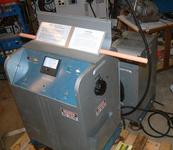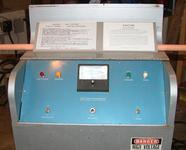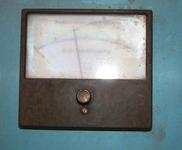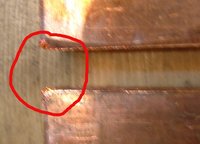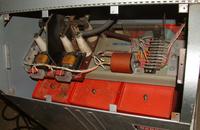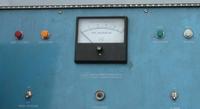 Up
Up
Featured here is a old Associated Research cable fault locator mdl 8613 also known as "thumper". It is labeled HyJoule. Its purpose is to help locate insulation faults in high voltage buried cable, by inducing giant DC pulsed discharges that blast through faulty insulation. The lineman would walk along the buried cable path and feel the "thumps" with his feet.
The way it works is this. The first device is a DC source, it uses about 10A of 120 VAC as supply and produces up to 25 kV DC as output. For safety when NOT in operation, when high voltage is switched off, high voltage side is grounded by a contactor. The second device is comprised of a high voltage capacitor, and a special high voltage contactor to produce periodic discharges. There is also high voltage cable that is supposed to be connected to the cable being tested. I would guesstimate the size of it as 7/8" in diameter and 50 feet in length.
With voltage up to 25 kV, and capacitance of 13 uF, my thumper is designed to deliver up to 4,062 joules, or approximately the energy carried by bullets from a burst of assault rifle fire.
I thought that it was not working.
Today, a local luminary in the field of coin shrinking, Lichtenstein figures, and other fun high voltage things visited me and my thumper machine. I am not mentioning his name out of respect for his privacy, and feel very highly about him.
After I dragged its two pieces into my garage, we looked at the machine and opened up the covers. Some interesting things came to light.
After he left, I wired up the machine and tried to use it. I made a primitive spark gap out of two large copper pieces. As it turned out, it works great. It charges the caps and when it reaches the preset voltage, it discharges into a spark gap.I only tried it at up to 10 kV.
